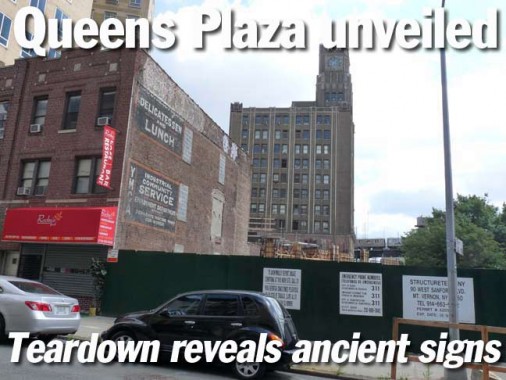Riding on the #7 train I always stake out a position near the door on the left side of the train. On the #7, that’s an ideal spot if you’re into looking out the window trying to spot anything new and Forgotten because the doors don’t open on that side at all between Flushing and Queensboro Plaza. I see the same sights every day, but you never know, a subtle change might come up.
During the summer, I saw just such a sight near the reconstructed Queens Plaza park at Queens Plaza North and 29th Street in southern Dutch Kills. Some newly uncovered painted ads have found the light due to a recent teardown. Soon, a huge multimillion dollar glass tower apartment building will rise here, but till then, these ads from, I’d guess, the 1940s, are available for urban spelunkers to peruse.
As you can see in the title card, you also have a unique perspective of the 15-story Bank of Manhattan building, which is still among the tallest in Queens, surpassed only by the 45-story Citigroup tower and the North Shore Towers in Glen Oaks.
From FNY’s 2007 Queens Plaza page (in which just about everything except this building has been demolished):
Long before Citi Tower was finished in 1989, the Queens Plaza area had its own skyscraper…the 15-story Bank of Manhattan building, finished in 1927…something Howard Roark himself may have conceived of. That year, American architecture was shedding Beaux Arts and adopting the more streamlined techniques of the Machine Age. That didn’t stop the Bank’s architects from adding all kinds of Easter eggs way up high, like the 4-sided clock, the water bearer, fish and shell.
Long Island Star- Journal, October 1925: The Bank of Manhattan’s new building for Queens Plaza will set the pace for the Long Island City skyline. The building will tower far over the present buildings. The projection is that Bridge Plaza will be the new Times Square of Queens. The 14 story building is to be graced with a four faced clock. The Plaza is expected to become the business and financial center of Queens. Transit facilities give it access to the South Shore as well North Shore. Greater Astoria Historical Society

There are two ads on the side of a 29th Street building, were both done by signpainter Bernard Yoepp. As a closeup look will reveal…

… they are in black with white lettering and red trim. Two rows of brick serve as the border and are painted a deeper red than the brick itself. Unfortunately, the name of the delicatessen had been re-bricked and just enough of it is covered so that the name can’t be made out, but it does look as if there is a single first initial followed by a period. That might be a clue for any of you who were around in the 1940s and 50’s and might remember it.
Does anyone remember a YMCA in the Dutch Kills area near Queens Plaza? One of the apparent attractions was a “separate waiting room for women” because we know, then as now, men are wolves.
That reminds me that the video for the Village People smash “YMCA” was shot way over on West Street at the Hudson River, and virtually nothing of the scenery shown in it (such as the Ramrod) remains today (besides the McBurney Y on West 23rd):
Up the block on 29th is this fantastical Art Deco 12-story former-office building at 41-15, also being converted to residences. The two beasts in the facade have a vulpine look about them.
Like its pal Hunters Point, Dutch Kills is forcibly being dragged into the 21st Century with a spate of glass office towers and high-rise hotels, built to offer an alternative to the more expensive Manhattan counterparts.
In 2009, I hiked around northern Hunters Point and southern Dutch Kills, and some of the sights seen that day are no more, even from that relatively recent date.
These staid older apartment buildings on the west side of 29th Street have gotten into the renewed Queens Plaza swing.
This 3-story building on 29th Street and Queens Plaza North is Q4, one of the new area hotels I just mentioned. It’s gotten several favorable reviews on yelp.
It’s one of the many former banks in the Queens Plaza area. How can you tell? It still says so on the 29th Street side: ‘Corn Exchange Bank & Trust Co.’
The Corn Exchange Bank was founded in 1853 in New York, but had branches in other states, including Pennsylvania, Wisconsin, and Nebraska. It was a retail bank that acquired many community banks. In 1855, the bank moved into an existing building at the northwest corner of William and Beaver Sreets [in Lower Manhattan]. In 1894, the bank completed a new headquarters, an 11-story building designed by Robert Henderson Robertson, at 11-15 William Street. Between 1923 and 1925 it held a small stake in the Connecticut-chartered Bank of Central and South America, together with a number of other New York banks. In 1929 it was renamed the Corn Exchange Bank and Trust Company. In 1954 it merged with Chemical Bank and the combined entity took the name Chemical Corn Exchange Bank. After Chemical Corn merged with New York Trust, the “Corn” was dropped. The Corn Exchange Bank in Philadelphia, Pennsylvania, was famously robbed by Willie Sutton in February 1933. wikipedia
9/17/13
